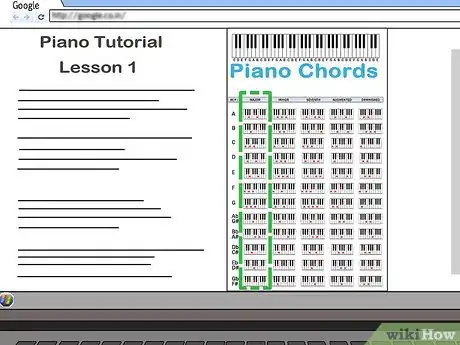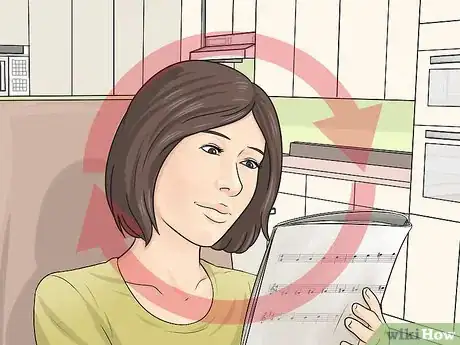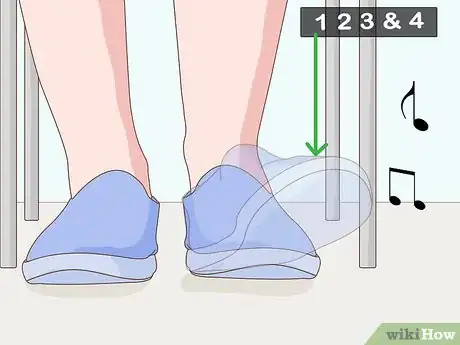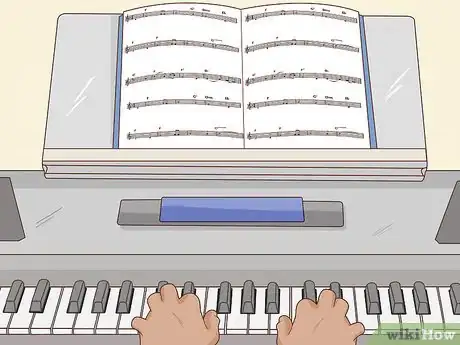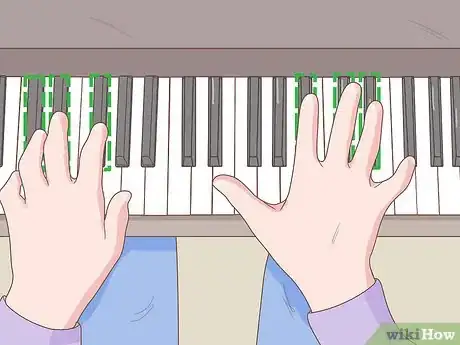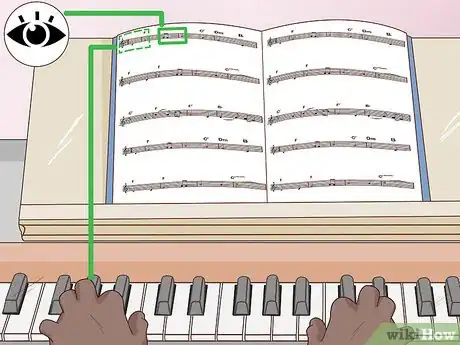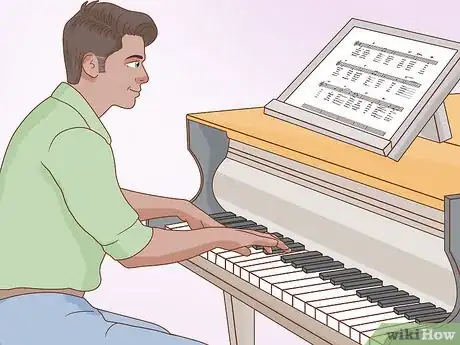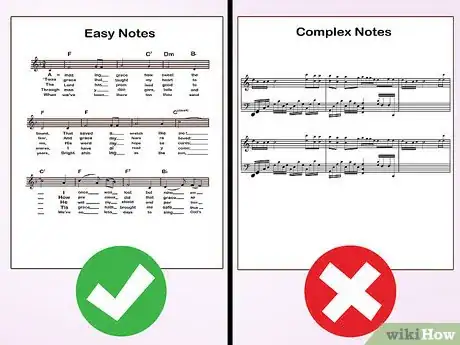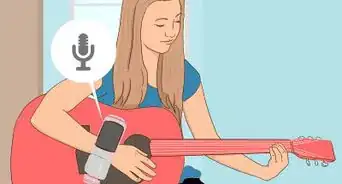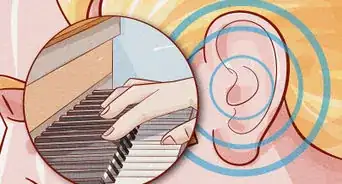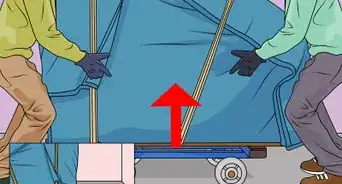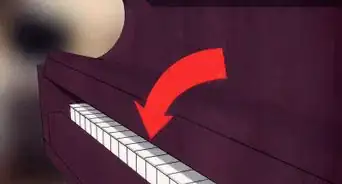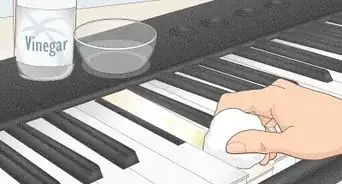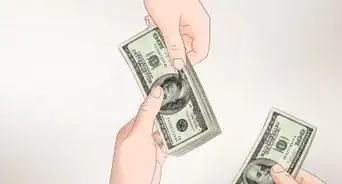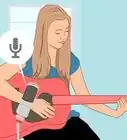This article was co-authored by Michael Noble, PhD. Michael Noble is a professional concert pianist who received his PhD in Piano Performance from the Yale School of Music. He is a previous contemporary music fellow of the Belgian American Educational Foundation and has performed at Carnegie Hall and at other venues across the United States, Europe, and Asia.
There are 10 references cited in this article, which can be found at the bottom of the page.
wikiHow marks an article as reader-approved once it receives enough positive feedback. In this case, 96% of readers who voted found the article helpful, earning it our reader-approved status.
This article has been viewed 669,839 times.
If you want to improve your piano playing skills, you must learn how to sight read sheet music. Sight reading is the act of playing a new song by just reading the music. Before you can start sight reading, you'll need to know how to read sheet music and understand basic music theory. If you perform drills and hone your music reading skills, you'll be able to perform almost any song that's put in front of you!
Steps
Doing Drills
-
1Purchase simple sheet music that you're unfamiliar with. Simple sheet music may include children's songs, holiday carols, and simple classical songs.[1] You can purchase beginner sheet music at a music store or online. Get a bunch of different examples so that you have a lot of material to practice with.[2]
- You can find simple sheet music from a piano book for beginners.
- Simple or beginner songs include "Amazing Grace," "Ode to Joy," and "Waltz."
- Once you can sight read simple songs, you’ll be able to move onto more complex material.
-
2Practice reading sheet music for 20 minutes a day. Before you can start sight reading, you’ll need to memorize the positions of notes on the staff so you can read the music without having to reference other materials. Read sheet music with a cheat sheet next to you at first so you can get used to reading notes. Eventually, you'll be able to read music much faster, which will help you play new pieces of music.[3]
- On the treble staff, the notes on the lines, from bottom to top, are E, G, B, D, F. You can memorize this by remembering the mnemonic device "Every Good Boy Does Fine."
- On the treble staff, the notes in between the spaces, from bottom to top, are F, A, C, E.
- Going through a number of different songs during each practice session will hone your music reading skills.
Advertisement -
3Say the notes out loud as you read the sheet music. Eventually, you'll need to incorporate the rhythm to play the music, but this exercise can help with your note memorization skills. Say the notes out loud while ignoring the rhythm until you're able to read the music faster.
-
4Download apps or visit websites to do more sight training drills. Apps and interactive games can help you hone your sight reading skills. Download sight reading apps and go through the modules. Look for programs that allow you to print out sheet music and software that has piano-specific drills.
- Popular apps include Sight Reading Mastery, Music Tutor, and NoteWorks.
-
5Play scales in the same key that the music is in. Find the key signature by looking to the right of the clef on the piece of music you plan on sight reading. Then, play the major and minor scales in that key. This will help you get acclimated to the area of the piano that you’ll be playing in.[4]
- Search beginner piano books and piano lesson websites to learn the 12 major scales.
- The C major scale is one of the most common scales. Its note sequence is C, D, E, F, G, A, B, and C.
Approaching Sheet Music
-
1Stick to a single clef when you practice. The treble clef and bass clef are the most widely used clefs in sheet music. The position of the notes on the sheet music are different depending on the clef. Become good at sight reading music that uses one clef before moving onto a different clef.[5] [6]
- The treble clef looks like 𝄞 , while the bass clef looks like a giant apostrophe with a colon 𝄢.
- On the treble clef staff, the five line notes from bottom to top are: E, G, B, D, F. The four space notes from bottom to top are: F, A, C, E.
- On the bass clef staff, the five line notes from bottom to top are: G, B, D, F, A. The four space notes from bottom to top are: A, C, E, G.
-
2Study the music before you play it. As you read the music, imagine the melody and rhythms in your head. Take a couple of minutes and locate areas that are difficult to play. Difficult parts may include quick transitions or a series of notes that you're not used to playing. Knowing when certain beats or parts are coming up will help you play more fluidly. Make a notation on the sheet music before these parts come up or try to memorize the flow of the song so that you can prepare for difficult sections.[7]
- You can also listen to the song to give you an idea of how it should sound.
-
3Tap your foot while reading the music to understand the rhythm. Half notes, whole notes, and quarter notes will provide the rhythm for the song. Before playing the song, practice clapping or tapping the rhythm. This will help you understand the rhythm of the music before you try to play it.[8]
- For instance, a whole note is 4 beats long. Count to 4 and tap your foot every time you say "one." This is how long you should hold a whole note.
- A half note is 2 beats long. Count to 2, and tap your foot every time you say "one."
- Quarter notes are 1 beat. Tap your foot 4 times over 4 seconds to copy the rhythm of 4 quarter notes playing in a row.[9]
-
4Set the music in front of you and sit at your piano. If the music is longer than 1 page, open the pages so that you can see both pages at the same time. Use pieces that are 2 pages or shorter so that you don’t have to flip through the pages as you play.
-
5Touch the black keys to correctly position your hands. If you know where the notes on the piano are without looking at your hands, it’ll make sight reading much easier. Glide your hand across the keys and feel for the black keys. If you need to play a C, D, or E, feel for the group of two black keys. If you need to play an A, B, F, or G, feel for the group of three black keys.[10]
- This exercise will build up your muscle memory so that you know where to position your hands while you play.
Playing Sheet Music
-
1Play each note slowly when you first start sight reading. Take your time and play each note in the sheet music. Play deliberately and get used to playing off the sheet music. Once you're more comfortable, you can pick up the speed in which you play.
-
2Read 2 notes ahead as you play the music. Once you get the notes down, you can start concentrating on rhythm. Always try to read ahead so that you know what comes next, even if you miss a note here or there. This is especially important if you have to flip to the next page. As you get better at sight reading, try to read several notes or beats ahead of what you're playing.[11]
- You'll know that you're ready to read ahead when you can comfortably sit in front of a new piece of music and follow along with the notes as you play.
-
3Play the piece all the way through without stopping. Skip over the notes that you missed and try to get back on the rhythm. Continue to follow the sheet music with your eyes as you play.[12]
-
4Keep your eyes on the music and don’t look down at your hands. Feel for the keys to ensure that your hands are in the right position. Use your hearing to recognize if you're off-key rather than looking down at your hands.[13]
- It will take time to learn to keep your eyes on the music, but this gets easier as you gain experience with sight reading.
-
5Ignore more complex note commands until you feel comfortable. The slower you go, the more time you’ll have to hit each key and the more accurate you'll be as you sight read. On the music, there may be tempo markings telling you to drastically change your rhythm. Ignore these markings until you're proficient at sight reading.[14] In addition to these markings, there may also be a notation above each note called an articulation. You should also ignore these.[15]
- Tempo markings will often be found on the top and to the left of the notes.
- Some examples of tempo markings include allegro (brisk), presto (very fast), moderato (moderately fast), grave (slow/solemn), and lento (slow).
- A small dot above the note is called a staccato and signifies that the note should be shorter in duration. This is an example of articulation.
- A slur is an articulation that looks like a curved line written above the notes. When you see this articulation it means that you shouldn't put any beats or spaces in between the notes.[16]
-
6Play another piece of sheet music. Once you're done playing the first piece of music, switch to a different piece and start the process over. Don't go back and try to play the first piece perfectly because that builds muscle memory, not sight reading skills.
Expert Q&A
Did you know you can get expert answers for this article?
Unlock expert answers by supporting wikiHow
-
QuestionHow can I get better at playing the piano?
 Michael Noble, PhDMichael Noble is a professional concert pianist who received his PhD in Piano Performance from the Yale School of Music. He is a previous contemporary music fellow of the Belgian American Educational Foundation and has performed at Carnegie Hall and at other venues across the United States, Europe, and Asia.
Michael Noble, PhDMichael Noble is a professional concert pianist who received his PhD in Piano Performance from the Yale School of Music. He is a previous contemporary music fellow of the Belgian American Educational Foundation and has performed at Carnegie Hall and at other venues across the United States, Europe, and Asia.
Professional Pianist
-
QuestionHow can I improve my sight reading for music?
 Michael Noble, PhDMichael Noble is a professional concert pianist who received his PhD in Piano Performance from the Yale School of Music. He is a previous contemporary music fellow of the Belgian American Educational Foundation and has performed at Carnegie Hall and at other venues across the United States, Europe, and Asia.
Michael Noble, PhDMichael Noble is a professional concert pianist who received his PhD in Piano Performance from the Yale School of Music. He is a previous contemporary music fellow of the Belgian American Educational Foundation and has performed at Carnegie Hall and at other venues across the United States, Europe, and Asia.
Professional Pianist
-
QuestionWhat does it mean to sight read music?
 Michael Noble, PhDMichael Noble is a professional concert pianist who received his PhD in Piano Performance from the Yale School of Music. He is a previous contemporary music fellow of the Belgian American Educational Foundation and has performed at Carnegie Hall and at other venues across the United States, Europe, and Asia.
Michael Noble, PhDMichael Noble is a professional concert pianist who received his PhD in Piano Performance from the Yale School of Music. He is a previous contemporary music fellow of the Belgian American Educational Foundation and has performed at Carnegie Hall and at other venues across the United States, Europe, and Asia.
Professional Pianist
References
- ↑ http://www.music-for-music-teachers.com/beginner-piano-music.html
- ↑ https://nafme.org/how-to-practice-sight-reading-in-15-minutes-a-day-in-just-4-steps/
- ↑ http://www.belmont.edu/music/PDFs/sightreading_tips.pdf
- ↑ http://www.belmont.edu/music/PDFs/sightreading_tips.pdf
- ↑ https://www.youtube.com/watch?v=k1qIczBADvc&feature=emb_logo
- ↑ https://scranton.instructure.com/courses/2/pages/treble-clef-and-bass-clef-lecture-and-notes
- ↑ https://www.musicnotes.com/now/tips/10-tips-tricks-sight-reading-music/
- ↑ https://www.musicnotes.com/now/tips/10-tips-tricks-sight-reading-music/
- ↑ http://monsterguitars.com/Rhythmic_Lead_Guitar_Chapter_1.pdf
- ↑ http://www.richmanmusicschool.com/articles/10-sight-reading-tips
- ↑ http://www.belmont.edu/music/PDFs/sightreading_tips.pdf
- ↑ http://sightreadingmastery.com/blog/4-sight-reading-tips-liszt-wants-you-to-know
- ↑ http://www.belmont.edu/music/PDFs/sightreading_tips.pdf
- ↑ http://sightreadingmastery.com/blog/4-sight-reading-tips-liszt-wants-you-to-know
- ↑ https://www.thoughtco.com/symbols-of-piano-music-ii-2701989
- ↑ https://www.thoughtco.com/symbols-of-piano-music-ii-2701989
About This Article
To practice sight reading piano sheet music, read simple sheet music for children's songs, holiday carols, or simple classical pieces. You should practice reading for 20 minutes per day. As you read the notes, try saying them out loud to help you memorize them. Additionally, test yourself on sight reading apps like Sight Reading Mastery or Music Tutor. Once you feel more confident, try listening to the piece of music as you read it, and tapping your foot to the rhythm so you get used to how you'll have to play the music on the piano. For tips on how to play the piano and sight read at the same time, keep reading!




